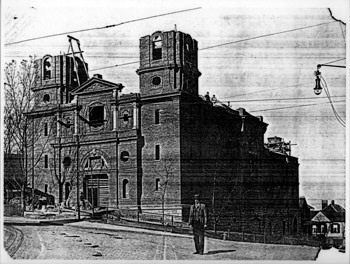Architect Rafael Guastavino lived for 66 fruitful years and, while he's not exactly a household name (public relations and "branding" were not his strong suit), he should be counted among the most prolific and inspired people of the past two centuries. He didn't live long enough to celebrate his own centennial, but his mortal remains remain in the crypt in the Mary Chapel of the Basilica of Saint Lawrence, the now-100-year-old National Historic Landmark in Asheville.

Guastavino ventured to the New World from Barcelona, Spain, in 1881, taking full advantage of this Promised Land and giving back to it some 1,000 beautiful, classic and unique public buildings that continue his legacy. On the island of Manhattan alone, he was involved in 300 epic structures, applying his trademark decorative-tile system and letting other lead architects take all the credit for monumental structures like Grant's Tomb, Grand Central Terminal and the Ellis Island Registry Room.
During the past decade, Guastavino's fame has mushroomed, especially in greater New York, Spain and North Carolina. Director Pam Myers, Curator Frank Thomson and a blue-ribbon committee of our own Asheville Art Museum assembled an excellent exhibit, Rafael Guastavino: Barcelona to Black Mountain, in the summer of 2002, which gave a visibility boost to Guastavino's work.
Guastavino's 1905 Basilica of Saint Lawrence collaboration with British architect Richard Sharp Smith stands as a singular sign of the melding of these two men's creative genius, though both were also involved with the 1895 Biltmore mansion.
1905 Asheville was, of course, a very different place socially, economically, religiously, racially and culturally. One third of the permanent residents of Asheville were black. The Buncombe Turnpike had been in existence for 55 years. The railroad had served the region for only 25 years. The trolley system was excellent, second only to the one in Richmond, Va.
The Basilica would not have become a reality without major interest and action by the world-famous James Cardinal Gibbons of Baltimore. Gibbons was the second U.S. Cardinal in history and a good friend of President Theodore Roosevelt. (When Gibbons was appointed Vicar of the entire state of North Carolina in 1868, there were fewer than 700 Catholics in the state.) Other key hierarchy that did the "heavy lifting" to bring the church to fruition were Benedictine Abbot Leo Haid of Belmont Abbey and Fathers Peter and Patrick Marion.
This masonry liturgical gem was listed on the National Register of Historic Places on March 24, 1978. It is presently a prime candidate for the National Park Service's grant program, "Save America's Treasures." (On a related note, Guastavino's lovely 1,000-acre Black Mountain estate was placed on the National Register on July 13, 1989.)
As the docents at the Basilica tours quickly inform you, the central figure on the main façade facing south to Haywood Street and Downtown Asheville is Saint Lawrence, holding in his left hand a palm frond and in his right a gridiron, the instrument of his torture and death in A.D. 258. Once inside this historic edifice, you are at once lifted by an example of Guastavino's "cohesive construction" magic — the largest freestanding, elliptical terracotta dome, spanning 82 feet by 58 feet.
Asheville is blessed with more than a dozen examples of outstanding liturgical historic architecture, and the upcoming celebration of the Basilica's Centennial causes us to give thanks to the Divine Architect for these gifts. Amen.
The Centennial celebration will conclude with an 11 a.m. mass at the Basilica conducted by the Diocese of Charlotte on Saturday, Oct. 17, followed by a reception at the Haywood Park Hotel.
William Flynn Wescott, P.E., Active Historic Preservation Consultant and Past President of the Preservation Society of Asheville & Buncombe County.
Guastavino … should be counted among the most prolific and inspired people of the past two centuries



Before you comment
The comments section is here to provide a platform for civil dialogue on the issues we face together as a local community. Xpress is committed to offering this platform for all voices, but when the tone of the discussion gets nasty or strays off topic, we believe many people choose not to participate. Xpress editors are determined to moderate comments to ensure a constructive interchange is maintained. All comments judged not to be in keeping with the spirit of civil discourse will be removed and repeat violators will be banned. See here for our terms of service. Thank you for being part of this effort to promote respectful discussion.